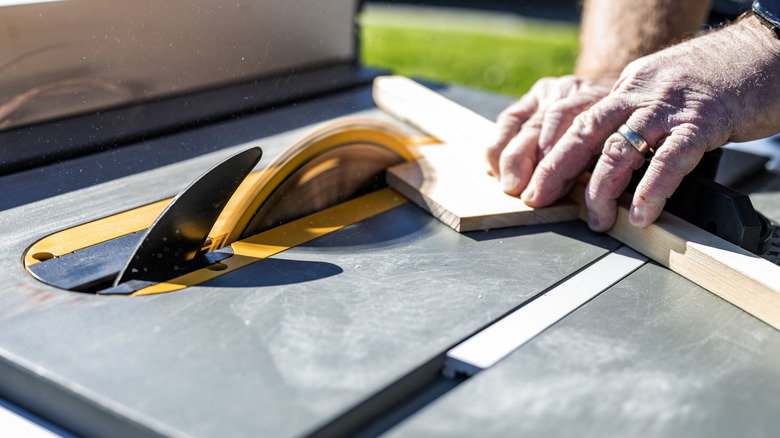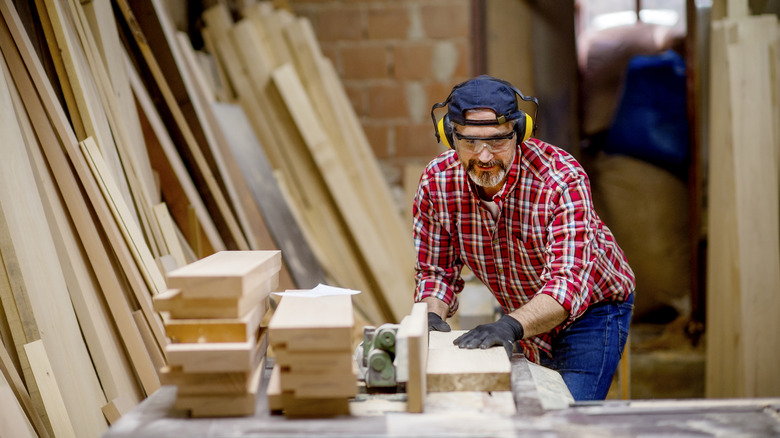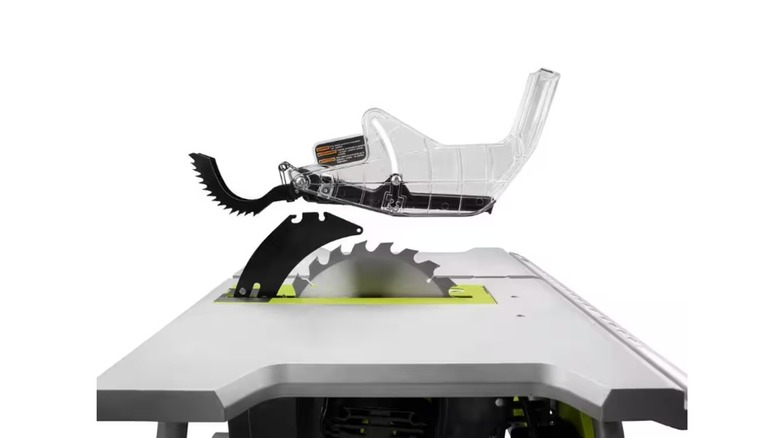What Makes The Table Saw One Of The Most Nerve-Racking Tools For Even Pros To Use
We may receive a commission on purchases made from links.
One look at a table saw, and it's not hard to understand why some may be apprehensive when working with it. Simply put, while many power tools can be dangerous, the table saw is one of the most hazardous workshop implements you can use. This is because the operator must push material toward the blade as it cuts, placing the hands close to the business end of this tool. Push sticks or push blocks are an invaluable aid when working with a table saw, but that's not the only accessory you need to stay safe while woodworking.
According to NPR, around 30,000 injuries requiring medical intervention occur as a result of the table saw blade, and as many as 4,000 end with amputations. As if contact with the blade wasn't frightening enough, table saws can also experience kickback, where the blade can fling material at high speed back towards the operator. It's not just beginners that fall victim to this tool, but also seasoned woodworkers and contractors, who only need to get complacent or experience a bit of fatigue, to make a mistake that could jeopardize the future of their career.
To demonstrate just how devastating a table saw blade can be to an operator, YouTube Channel Blacktail Studio put together a demonstration on their video Woodworking Injuries in Slow Motion. Using a ballistic gel hand and lower arm as a human substitute, you can see just how dangerous it can actually be to work with this equipment.
So why not use another tool if table saws are so dangerous?
You can opt for an alternative to a table saw, but unfortunately, even as stressful as it can be to operate, it's a very versatile tool. With a large, flat workspace, a lengthy cutting guide (fence), and a variety of blade positioning options, there's really nothing that makes long straight cuts better. In addition, for the sake of efficiency and time savings, a table saw is the best option when you need to make repeated but accurate cuts.
A table saw can also easily perform dado cuts, which are created to form wood connecting joints for furniture. By lowering the position of the blade further into the table, you can remove select sections of wood without cutting all the way through. A basic example of this would be constructing a bookshelf, which can use dado joints on each side, allowing the ends of the shelves to slide into dado cuts for support.
How you can make a table saw safer
Modern table saws offer safety accessories that you shouldn't remove, especially if you're new to the tool. Material kickback is a hazard, and one way this can happen is when the cutting piece begins to pinch the blade. To mitigate this risk, something called a riving knife (a thin fin-like implement just behind the blade) helps reduce the chances of kickback by keeping each half of the cut pieces apart. However, on many demonstration videos, safety equipment like this is removed, leading some to think it isn't necessary. In actuality, these components are removed solely to allow the viewer to see more of what's happening and are essential for normal use. Only when performing more specialized cuts using dado sets, for example, would you consider removing the riving knife.
There is also a guard that sits over the blade and helps prevent a dropped piece of wood or your hands from falling onto the spinning teeth. However, these guards can be bulky and partially block the operator's view. As tempting as it might be to remove it, its role on the table saw is an important one.
While pricier, you may consider buying a table saw with a unique piece of safety technology, SawStop. The magic behind SawStop and how it works is a revolutionary step in injury prevention that will hopefully become a standard in the future. However, as of today, this system isn't available outside of the SawStop brand.


